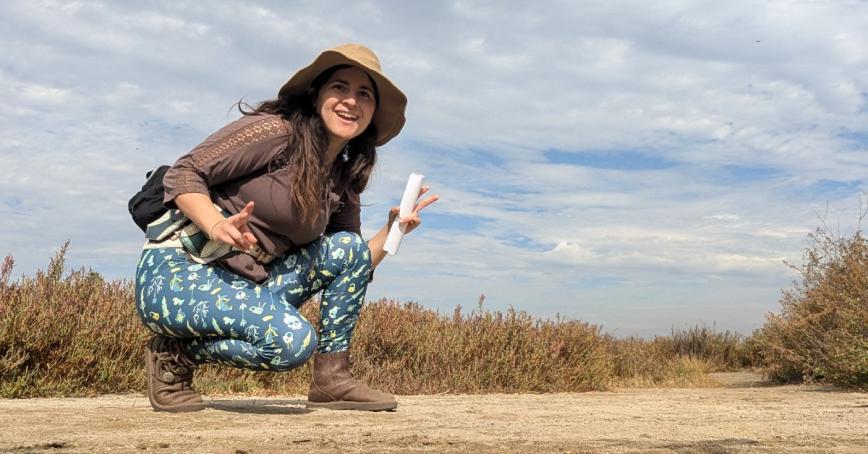Movement as Method: embodied path to ecological understanding
Topics
Featured
Share online

Learn more about the Master of Arts in Environmental Education and Communication.
Most thesis defenses don’t involve martial arts. But then, most theses don’t ask what it means to become a mountain—or move like the ocean.
Crystal Sandoval is graduating this June from the Master of Arts in Environmental Education and Communication (MAEEC) program at Royal Roads University with one of the highest academic honours: a rare pass with distinction and no required revisions on her thesis. It’s a recognition typically reserved for work that excels on every front—research, conceptualization, analysis, presentation.
But what truly sets Sandoval’s project apart is its ability to move across form and discipline with integrity, creativity, and heart.
Her thesis, titled Mountain and Ocean Strikes: Exploring an Embodied Sense of Place and Ecological Identity in Kaihewalu Lua, is as immersive as its name suggests. Drawing from years of martial arts practice, environmental teaching, and cross-cultural experience, Sandoval shaped a project that is intellectual, emotional, and deeply physical. She filmed herself in motion. She mapped her thesis onto the geography and hydrologic cycle of a watershed, using it as a guiding metaphor for both the structure of the paper and the flow of her analysis.
“My body was part of the data. To try and explain it without moving felt like trying to describe the ocean without getting wet.”
Growing up in Los Angeles, Sandoval dreamed of becoming a scientist.
“Whenever people asked what I wanted to be when I grew up, I’d say a scientist,” Sandoval recalls. “Or a writer. Or a ninja.”
Her path began at UCLA, where she entered a competitive marine biology program. But after struggling with the program’s structure and being advised to change majors, she pivoted to linguistics and anthropology. She didn’t let go of her environmental interests. She kept volunteering at an aquarium. She kept teaching. And she kept practicing martial arts—something she’d been doing since she was six.
While teaching in Japan after graduation, she took a course on satoyama, a concept describing the relationship between people and nature. The course reignited her passion for environmental education and gave her language for something she’d long sensed: that ecological understanding can be both physical and relational.
Back in California, she searched for graduate programs that could support interdisciplinary and embodied inquiry. Royal Roads stood out—both for its blended format and its openness to innovative research methods. She enrolled in the graduate certificate first. After excelling in her courses, she transitioned into the full MAEEC program. One of her early mentors, program head and professor Dr. Hilary Leighton, remembers that transition well.
“Crystal came in with this beautiful humility and deep curiosity,” says Leighton, an ecopsychologist and longtime faculty member. “She metabolized the work in a way that wasn’t just intellectual—it was lived. Her thesis is one of the most original and moving pieces I’ve seen.”
Sandoval was introduced to the Hawaiian martial art of Kaihewalu Lua during a seminar at UCLA. It focuses on natural movement, drawing inspiration from animals and elements like birds and waves. As her Royal Roads coursework explored ecological identity, she began to imagine a thesis that integrated the two. She kept journals. Filmed herself moving. And began organizing the project not by academic chapter, but by hydrologic cycle.
“The movements of my body became like water flowing through a landscape,” she says. “They shaped the thesis. They shaped me.”
Her supervisor, Dr. Bob Kull, encouraged her to lean further into her personal reflections and multimodal expression. She revised her drafts, shot new videos, and incorporated original audio and visual material alongside academic writing. The final product is a dynamic, multimodal experience—a vivid demonstration of what environmental education can become.
When it came time to defend her thesis, Sandoval didn’t just talk about her research—she moved through it. Her final presentation included a physical demonstration of the martial art that shaped her work. Her Lua teacher attended. So did her professors.
“There wasn’t a dry eye in the house,” says Leighton. “She didn’t just write about transformation—she embodied it.”
The external reviewer praised Sandoval’s thesis for its academic strength and innovative form, calling it “a vivid and alive reading experience” that exemplifies how ecological education can be immersive, relational, and culturally respectful.
One passage, the reviewer noted, powerfully captures the heart of the work: “The conscious inhabitance of my body raised my awareness of how I presented myself and connected with other humans and nonhumans, which deepened my sense of place because I was more mentally and physically prepared to receive lessons.”
Today, Sandoval teaches at the Heal the Bay Aquarium in California, where she applies the same principles she explored in her thesis. She teaches with intention, openness, and acceptance—three values she now sees as integral to learning and being.
“Whether I’m teaching science or storytelling, I try to show up with those qualities,” she says. “That’s what this work taught me.”
Her advice for students considering creative or multimodal research methods is simple: Go for it—but be prepared. “It might take more time. It might feel like there’s no model to follow. But the depth that comes from it? It’s worth everything.”
Asked what she’s most proud of, Sandoval doesn’t hesitate.
“That I didn’t give up. There were years where it would have been easier to stop. But I had a story I wanted to tell. And I told it.”
She may not be a marine biologist, full-time writer, or literal ninja—but through Mountain and Ocean Strikes, Crystal Sandoval has found her own way to be all three.
Learn more about the Master of Arts in Environmental Education and Communication.